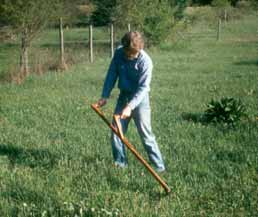We first had
one of those heavy, hardware store models -- which was a joke, though not a very
funny one if you were trying to do any serious work with it. Then we splurged
for a model made by
Hand & Foot in Brattleboro, Vermont. After more than thirty years it is still in great shape.
The snath (the wood part) is straight with movable handles to fit different sized people.
This part would be easy to make. The blade is of high quality steel, thinner and lighter
than the hardware store monster. It sharpens well to a razor edge. This would not be easy
to make, unless you were very, very skilled in blade making. Keep an eye open for a good
one, new or used. It will be worth a hundred bad blades.
The tool is a real joy to use, even if you aren't that proficient, which I'm not. I've
been tempted when I've finished mowing a section with the scythe to take the power
lawnmower to it to hide the terrible haircut, especially when it is right next to Steve's
neatly mowed patch! But I enjoy it anyway.
Learning to use the scythe is more a matter of loosening up and letting the tool do its
job, joining its rhythm. Don't worry if you don't quite have the muscles for it when you
begin -- they will come!
This is a tool for the grasses, not for sapling and brush. But it is very handy, even if
you aren't cutting hay or grain. We've used it for what might loosely be called "lawn
mowing", as well as for mowing mulch hay, cutting down green manure plots
in the garden, knocking down various "weedy/light brushy" spots,
around the fruit trees, and grain harvesting. It is handy, peaceful, fun. It's a
very satisfying tool. Good exercise, too!
POWER MOWING and Your GARDEN
For years I'd read that you had to keep the area around my garden well mowed to
keep the insects and weeds back. And for years I did just that. We had (and have) very
little mowed area around our home and "yard" (actually fields between forest),
but the area around the garden was well shorn.
When we had chickens they enjoyed this mowed area, especially as I was mowing (with a
gasoline mower). They would come running when they heard the machine and
would scramble all around after the grasshoppers and other insects that were flushed out
by the roaring engine. You had to be careful not to mow a chicken a two. But when the hawks
and owls came around, the chickens were much safer in the tall growth around the edges.
The chickens are gone many years now, and I don't mow as much. The field/lawn
often grows tall around the garden and orchard. Sometimes it is cut it for mulch,
sometimes left to flower for the pollinators, late fall I often mow to help with
vole control (giving hawks and weasels easier access).
Mostly I mow paths and patches -- around the garden, to and from the garden shed, the windmill,
around the
fruit trees, the gate. Where ever we traverse often, and areas where we work. We
enjoy the varied vegetation. We had insects when I mowed more, and we have
insects when I mow less. It all seems to even out.
I use an
electric battery powered mower now, one that can be charged up from our solar
electric system. It is certainly more pleasant than the gasoline mower, but it
does have a noise of its own. These mowers have come a long way since our first
ones. They are much more practical now, and the technology is getting better as
they become more popular. I often ask mine to mow vegetation much taller than the manufacturer planned,
and so far it keeps on going. I
still use the wonderfully quiet scythe now and then. I enjoy using whatever tool
fits my needs and desires at the time.
* * * * * *
Copyright ©
Susan Robishaw



